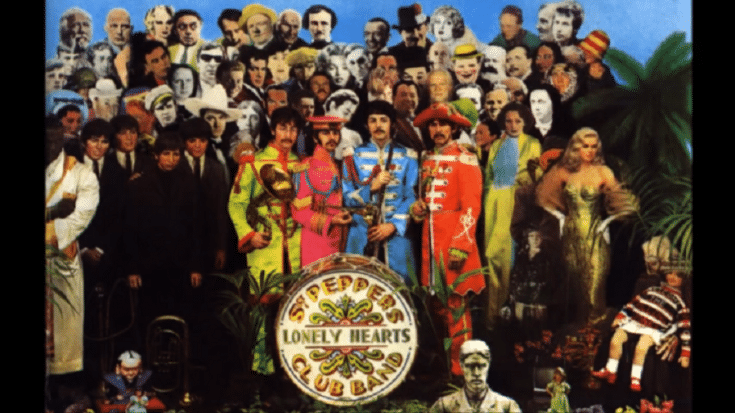How The Beatles Wrote “A Day In The Life”

via tuquelex/YouTube
Banned By The BBC
Even with several brilliant songs on The Beatles’ Sgt. Pepper’s Lonely Hearts Club Band, the John Lennon-penned A Day in the Life was a standout.
In the middle of January 1967, Lennon wrote most of the lyrics and melody as he was reading that day’s newspaper. Two stories jumped out at him. According to Lennon, “One was about the Guinness heir who killed himself in a car. That was the main headline story. He died in London in a car crash. On the next page was a story about four thousand potholes in the streets of Blackburn, Lancashire, that needed to be filled.” The millionaire socialite Tara Browne was actually a friend of The Beatles and he was just 21 years old when he drove his Lotus Elan at high speed in South Kensington, London. Since he failed to notice it was a red light, he crashed into a van.
Lennon kept on writing and playing the piano with the Daily Mail propped in front of him. But the lyrics didn’t exactly describe what he had read. He drew inspiration from the tragic events but he “didn’t copy the accident. Tara didn’t blow his mind out. But it was in my mind when I was writing that verse.”
He then showed it to Paul McCartney and they worked together to finish the track. And they were back to the kind of collaboration they did in their early years. Lennon said, “The way we wrote a lot of the time: you’d write the good bit, the part that was easy, like “I read the news today” or whatever it was, then when you got stuck or whenever it got hard, instead of carrying on, you just drop it; then we would meet each other, and I would sing half, and he would be inspired to write the next bit and vice versa. He was a bit shy about it because I think he thought it’s already a good song … So we were doing it in his room with the piano. He said “Should we do this?” “Yeah, let’s do that.””
Lennon admitted, however, that McCartney’s contribution was limited to “the beautiful little lick in the song, ‘I’d love to turn you on,’ that he’d had floating around in his head and couldn’t use. I thought it was a damn good piece of work.”
In his 1997 official biography Paul McCartney: Many Years from Now, Macca said that while working on the song, he wasn’t thinking of Tara Browne. He added, “I was not attributing it to Tara in my head. In John’s head it might have been. In my head I was imagining a politician bombed out on drugs who’d stopped at some traffic lights and didn’t notice that the lights had changed. The ‘blew his mind’ was purely a drugs reference, nothing to do with a car crash.”
The middle section was actually an unfinished song McCartney previously wrote and yet somehow, it perfectly fit A Day in the Life. Macca revealed, “It was another song altogether but it happened to fit. It was just me remembering what it was like to run up the road to catch a bus to school, having a smoke and going into class. It was a reflection of my schooldays. I would have a Woodbine, somebody would speak and I’d go into a dream.”
And for the final verse, Lennon used the second headline – the pothole problems. He struggled to find the right term, “There was still one word missing in that verse when we came to record. I knew the line had to go ‘Now they know how many holes it takes to… something, the Albert Hall.’ It was a nonsense verse really, but for some reason I couldn’t think of the verb. What did the holes do to the Albert Hall?
“It was Terry [Doran, a former car dealer and friend of Brian Epstein’s who later became head of Apple Music] who said ‘fill’ the Albert Hall. And that was it. Perhaps I was looking for that word all the time, but couldn’t put my tongue on it. Other people don’t necessarily give you a word or a line, they just throw in the word you’re looking for anyway.”
The “I’d love to turn you on” line was the reason the song was banned by the BBC – but McCartney admitted they were aware of the drug reference while writing it, “I had this sequence that fitted, ‘Woke up, fell out of bed’, and we had to link them. This was the time of Tim Leary’s ‘Turn on, tune in, drop out’ and we wrote, ‘I’d love to turn you on.’ John and I gave each other a knowing look: ‘Uh-huh, it’s a drug song. You know that, don’t you?'”
But when the ban was announced, Lennon reacted with: “The laugh is that Paul and I wrote this song from a headline in a newspaper. It’s about a crash and its victim. How can anyone read drugs into it is beyond me. Everyone seems to be falling overboard to see the word drug in the most innocent of phrases.” Even McCartney told the reporters that “The BBC have misinterpreted the song. It has nothing to do with drug taking. It’s only about a dream.”



















